In 1977, Radio Shack became one of the first companies to sell personal computers, but it didn’t have a model with color graphics until 1980. This is the story of the Radio Shack Color Computer.
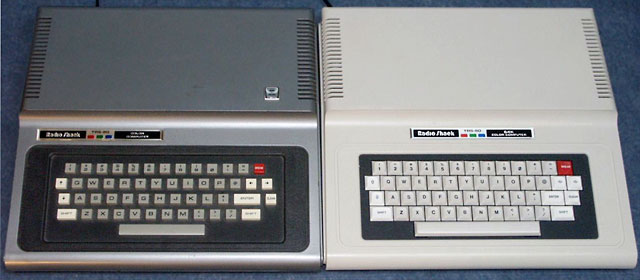
First generation Color Computer in original silver and later white case.
A Different Kind of TRS-80
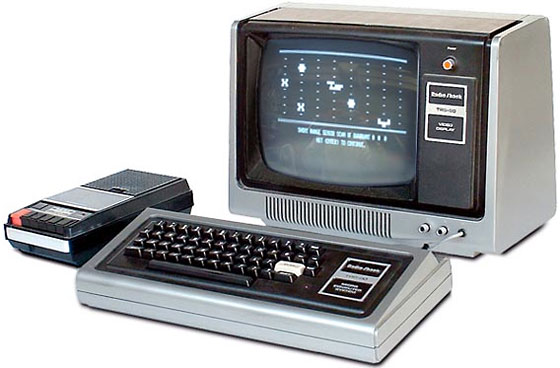 Although it shared TRS-80 as part of its name with Tandy’s black-and-white personal computers, the Color Computer was an entirely different machine. The original TRS-80 line was built around the Zilog Z-80 CPU, while the Color Computer used the Motorola 6809E CPU. That means no software was compatible between the two lines.
Although it shared TRS-80 as part of its name with Tandy’s black-and-white personal computers, the Color Computer was an entirely different machine. The original TRS-80 line was built around the Zilog Z-80 CPU, while the Color Computer used the Motorola 6809E CPU. That means no software was compatible between the two lines.
Color and Home Computing
The Apple 1, a single-board computer introduced in 1976, was the first model to support a color display, and the Apple II, released in 1977, was the first fully assembled computer with a color display. In 1978, Atari released its first personal computers. Befitting its history in video gaming, the Atari 400 and 800 had color support.
Texas Instruments joined the home computer market with its 99/4A in 1979 – it even included its own 13″ color monitor. Commodore jumped on color in 1980, when it released the VIC-20, the same year that Tandy introduced the first TRS-80 Color Computer.
Origin of the Color Computer
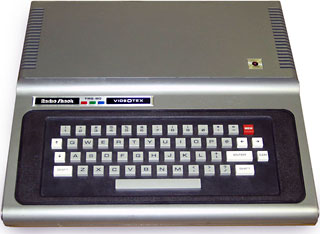 Radio Shack teamed up with Motorola in 1977 to create a lower-cost home computer. The first product was a home terminal that could be used with an ordinary color TV, eliminating the cost of a computer monitor. Motorola sold it as the AgVision terminal, while Radio Shack called it the VideoTex Terminal (right). Fans of the Color Computer will immediately see the origin of its case.
Radio Shack teamed up with Motorola in 1977 to create a lower-cost home computer. The first product was a home terminal that could be used with an ordinary color TV, eliminating the cost of a computer monitor. Motorola sold it as the AgVision terminal, while Radio Shack called it the VideoTex Terminal (right). Fans of the Color Computer will immediately see the origin of its case.
The VideoTex Terminal used a 6809 CPU, 6883 Synchronous Address Multiplexer, and 6847 Video Display Generator, all from Motorola.
On July 31, 1980, Radio Shack delivered the TRS-80 Color Computer, essentially a VideoTex Terminal minus its modem but with a cartridge slot, I/O ports, and joysticks. That model had 4 KB of memory and 8 KB of ROM that included Microsoft BASIC, which Tandy called Color BASIC. The new computer retailed for $399 at Radio Shack stores across the US and Canada.
The friendly little computer soon acquired the nickname CoCo, for Color Computer.
As with the older TRS-80 line, there were different levels of BASIC for CoCo. Color BASIC was the core language, and Extended Color BASIC was a more powerful version of the language. When the Color Computer got a floppy drive, Disk Extended Color BASIC arrived, and the final iteration was Super Extended BASIC for the CoCo3 – but we’re getting ahead of ourselves.
CoCo was meant to connect to your color TV, and it used program cartridges like Atari home computers and game consoles.
CoCo 1
The original Color Computer used the same chiclet style keyboard as the VideoTex Terminal and the same 0.895 MHz 6809 CPU. (I believe this was the only home computer to run at less than 1 MHz, although not by much.) Although there was a 4 KB version, you needed at least the 16 KB version to use Color BASIC, which was included with the 16 KB and 32 KB machines. A 64 KB model was later added and the 4 KB and 32 KB versions were phased out. Extended Color BASIC was a $99 upgrade.
Later on, CoCo got a full-stroke keyboard and came in a white case, replacing the silver of the original.
TRS-80 MC-10
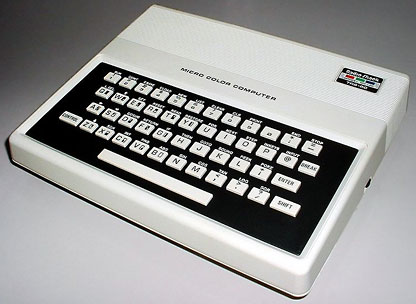 In 1983, Tandy introduced a smaller, lower cost version of the Color Computer, the TRS-80 MC-10, to compete with the Commodore VIC-20 and Sinclair ZX81. Unfortunately, the MC-10 was crippled to prevent it from competing with the full sized Color Computer. It had just 4 KB of memory (20 KB maximum), used a Motorola 6803 CPU, and its graphics matched those of the CoCo1.
In 1983, Tandy introduced a smaller, lower cost version of the Color Computer, the TRS-80 MC-10, to compete with the Commodore VIC-20 and Sinclair ZX81. Unfortunately, the MC-10 was crippled to prevent it from competing with the full sized Color Computer. It had just 4 KB of memory (20 KB maximum), used a Motorola 6803 CPU, and its graphics matched those of the CoCo1.
On the plus side, it sold for only $120. On the minus side, you needed to add an external keyboard to actually type, as the tiny keyboard didn’t allow for touch typing.
The home computer industry was moving to more powerful models, not less powerful ones, and the MC-10 was discontinued after one year.
CoCo 2
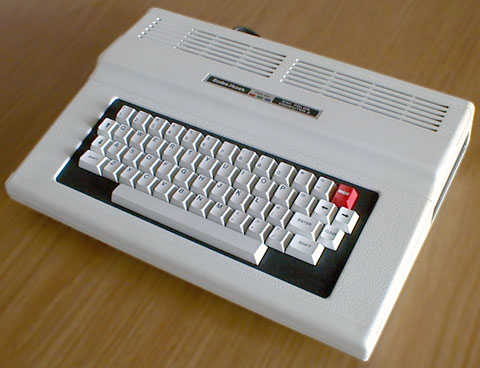 Radio Shack introduced the Color Computer 2 in 1983. It was functionally identical to the CoCo 1, but its smaller logic board allowed Tandy to produce a case about 25% less deep than the CoCo 1.
Radio Shack introduced the Color Computer 2 in 1983. It was functionally identical to the CoCo 1, but its smaller logic board allowed Tandy to produce a case about 25% less deep than the CoCo 1.
The CoCo’s BASIC ROMs were updated to correct some bugs and add some minor new features. A new graphics chip added support for lowercase text. During the production run for the CoCo 2, the original keyboard was replaced by a full-stroke keyboard, and some machines were built in Korea while others were assembled in the US.
![]()
For CoCo enthusiasts, this is the model where the name changed from Radio Shack TRS-80 Color Computer to Tandy Color Computer. When the nameplate was updated for the new name, the three colored boxes on it became parallelograms.
The CoCo 2 was phased out in 1986 to make room for the CoCo 3.
CoCo 3
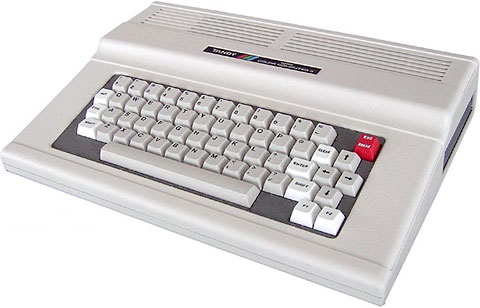 Tandy took things to the next level with the Color Computer 3, introduced on July 30, 1986 at $219.95 (or just $199 in Canada due to the exchange rate). Memory started at 128 KB and went as high as 512 KB (third party upgrades to 2 MB were possible).
Tandy took things to the next level with the Color Computer 3, introduced on July 30, 1986 at $219.95 (or just $199 in Canada due to the exchange rate). Memory started at 128 KB and went as high as 512 KB (third party upgrades to 2 MB were possible).
The keyboard was rearranged to put the arrow keys in a diamond configuration, and the area surrounding the keyboard went from black to grey. New keys included Ctrl, Alt, F1, and F2. This is the quickest visual clue that you’re looking at a CoCo 3 rather than a CoCo 2.
CoCo 3 had a new graphics chip called GIME, which gave it support for RGB and composite output as well as TV output like the earlier models. New text modes included 16 or 24 lines of text and 32, 40, 64, or 80 characters per line – all with true lowercase characters.
Graphic resolutions of 160, 256, 320, or 640 pixels wide by 192 to 225 rows, and up to 16 colors displayed from a palette of 64.
Using software control, the 6809E CPU could be accelerated to 1.79 MHz, doubling its processing power.
A Faster CoCo
Hitachi makes the CMOS 6309 CPU, which is its version of the 6809. In addition to running faster (3.5 MHz), it includes advanced features, new instructions, and more registers. The 6309 is generally 30% faster than the 6809 in native mode. This has been a popular upgrade, especially on the CoCo 3.
CoCo’s Secret Weapon: OS-9
Tandy didn’t have the kind of operating system the Color Computer needed to compete. The 6809 was perhaps the most sophisticated 8-bit CPU ever, but it was never allowed to reach it potential using Tandy’s operating system.
Fortunately, a project was launched in 1979 to set free the 6809. Known as OS-9, the new Unix-like operating system was written in assembly language for the 6809 CPU, and it was even available from Radio Shack. OS-9 Level One supported a 64 KB address space and could hold multiple processes within that 64 KB. Level Two extended that to 2 MB of memory – four times Tandy’s maximum for the Color Computer 3.
Microware describes OS-9 as a high performance, high availability real-time operating system, and it has grown well beyond the 6809 CPU. You can run OS-9 on x86, 680×0, PowerPC, ARM, and a few other CPUs.
There is a fork known as NitrOS-9, which is specific to the Color Computer and its clones. NitrOS-9 was initially designed for the Hitachi 6309 CPU but has since been back-ported to the 6809 so all CoCos can run it.
The End
After a 10 year run, Tandy dropped the Color Computer on October 26, 1990. The PC world had embraced Intel x86 architecture (as had Tandy), and the Amiga, Atari ST, and Macintosh were all built on Motorola’s 680×0 architecture, which was much more powerful than the 8-bit Motorola 6809E that powered CoCo.
Further Reading
- TRS-80 Color Computer, TRS-80 MC-10, OS-9, Wikipedia
- CoCopedia
- TRS-80 Color Computer, trs-80.com
- The TRS-80/Tandy Color Computer CoCo SuperSite!
- Radio Shack TRS-80 Color Computer, oldcomputers.net
- TRS-80 Color Computer Archive
- Microware, publisher of OS-9
- NitrOS-9
- The NitrOS-9 Project wiki
Keywords: #colorcomputer #6809 #6809cpu #trs80
Short link: http://goo.gl/xVIHmM
searchword: colorcomputer

